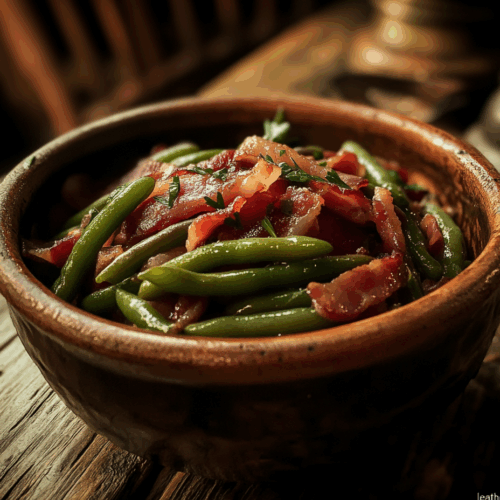In the annals of American history, few figures are as polarizing as Andrew Jackson. A war hero, a populist president, and a man of the frontier, Jackson’s life was as rugged as the land he helped shape.
His legacy is a mix of admirable leadership and controversial decisions, but one thing remains undisputed: his deep connection to the Southern way of life. Today, we explore one of the dishes that likely graced Jackson’s table—Leather Britches.
This humble yet flavorful dish, made from dried green beans, embodies the spirit of the frontier and the resourcefulness of the people who tamed it.
The Life of Old Hickory
Andrew Jackson, the seventh president of the United States, was born on March 15, 1767, in the Waxhaws region, straddling the border between North and South Carolina. Orphaned at a young age, Jackson grew up tough, developing a fierce independence that would define his life.
His military career skyrocketed during the War of 1812, where he earned the nickname “Old Hickory” for his steadfastness and resilience. Jackson’s victory in the Battle of New Orleans made him a national hero and paved the way for his political career.
Andrew Jackson’s Presidency
Andrew Jackson’s presidency, spanning from 1829 to 1837, was one of the most influential and contentious periods in American history. Known as the first “people’s president,” Jackson’s rise to power marked the ascendancy of the common man in American politics, a shift from the previous dominance of elite politicians.
His leadership style was bold and assertive, often bypassing traditional political norms to achieve his goals. One of his most significant actions was his staunch opposition to the Second Bank of the United States, which he viewed as a tool of the wealthy elite against the common people.
Jackson’s veto of the bank’s recharter and subsequent withdrawal of federal funds from the institution led to the “Bank War,” a pivotal moment that shaped the future of American financial policy.
Jackson’s presidency was also marked by his controversial implementation of the Indian Removal Act of 1830, which led to the forced relocation of thousands of Native Americans from their ancestral lands in the southeastern United States to territories west of the Mississippi River.
This tragic event, known as the Trail of Tears, has left a dark legacy on Jackson’s time in office. Despite these controversies, Jackson remains a significant figure in American history for his efforts to make the government more accessible to the average citizen and for his role in expanding the powers of the presidency.
His tenure in the White House reflected his belief in a strong executive branch and his determination to protect what he perceived as the interests of the common people, even if it meant challenging established institutions and norms.
Andrew Jackson’s Connection to Leather Britches
Leather Britches is a dish that perfectly captures the spirit of Jackson’s frontier life. On the frontier, preservation was key, and drying green beans for use in the winter months was a common practice.
Jackson, who spent much of his life on the frontier before moving to the White House, would have been familiar with this method of food preservation. The dish itself is a testament to the resourcefulness of early Americans, who made the most of what they had available to survive in the wilderness.
For Jackson, this dish was likely more than just sustenance; it was a reminder of his roots, a connection to the land and the people who settled it. Leather Britches, with its simple ingredients and deep, smoky flavor, embodies the rugged, no-nonsense attitude that Jackson himself personified.
The Dish Explained: Leather Britches
Leather Britches is made by stringing up fresh green beans and hanging them to dry in a warm, well-ventilated area. Once dried, the beans are simmered with a piece of pork fat, infusing them with a rich, smoky flavor. The name “Leather Britches” comes from the appearance of the beans after drying—they resemble old, weathered leather, a fitting name for a dish born out of necessity and resilience.
This dish is a perfect representation of Southern cooking at its most authentic—simple, flavorful, and deeply rooted in tradition. It’s a dish that would have been a staple in many Southern households during Jackson’s time and continues to be enjoyed by those who appreciate its history and taste.
If you’re enjoying my work, consider checking out Eats History Shop for my e-cookbooks!

Andrew Jackson’s Leather Britches
Ingredients
- 1 pound fresh green beans
- 2 ounces of salt pork or bacon
- 1 teaspoon salt optional
- Water
Instructions
Dry the Beans:
- String and break the fresh green beans, leaving them in long pieces.
- Thread the beans onto a needle and string, making sure to space them out for good airflow.
- Hang the beans in a warm, dry place (like an attic or a kitchen) for at least 2-3 weeks until they are fully dried and leathery.
Prepare the Dish:
- Rinse the dried beans to remove any dust or debris.
- In a large pot, add the dried beans and enough water to cover them by about 2 inches.
- Add the salt pork or bacon to the pot.
- Bring to a boil, then reduce the heat to low and simmer for 3-4 hours, or until the beans are tender. Stir occasionally and add more water if necessary to keep the beans covered.
Season and Serve:
- Taste the beans and season with salt if needed.
- Serve hot, ideally alongside other traditional Southern dishes like cornbread or collard greens.